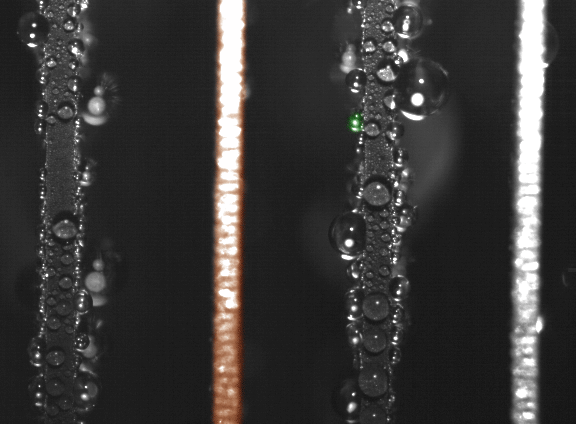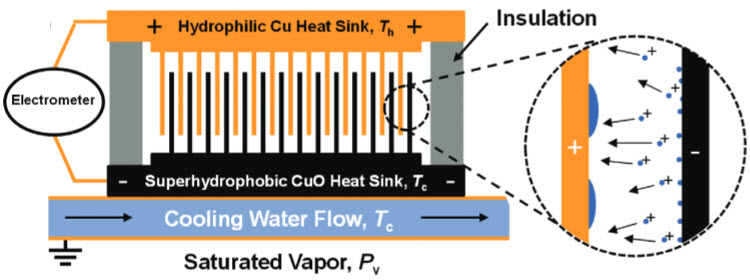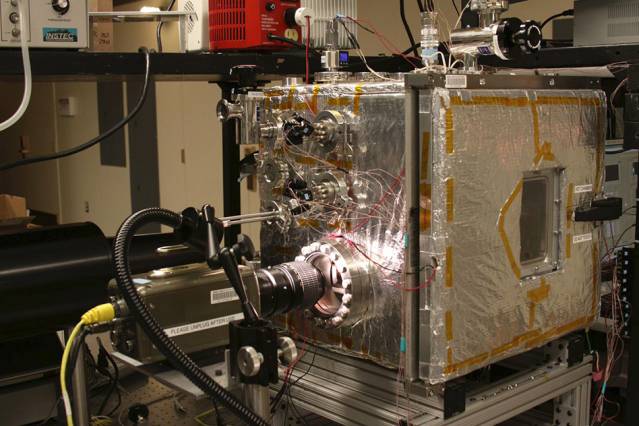Generating electricity from water droplets
July 18, 2014

False-color time-lapse images captured via high-speed imaging show a droplet jumping (colored green) from a superhydrophobic (water-repelling) copper oxide fin to a hydrophilic (water-attracting) copper fin (colored orange) (credit: Nenad Miljkovic and Daniel J. Preston)
MIT researchers discovered last year that when water droplets spontaneously jump away from superhydrophobic (water-repelling) surfaces during condensation, the droplets can gain electric charge in the process.
Now the same team has demonstrated that this process can generate small amounts of electricity, which could lead to devices that can charge cellphones or other electronics using just the humidity in the air. As a side benefit, the system could also produce clean water.
The device itself could be simple, says MIT postdoc Nenad Miljkovic, Department of Mechanical Engineering NanoEngineering Group, consisting of a series of interleaved flat metal plates. Although his initial tests involved copper plates, any conductive metal would do, including cheaper aluminum, he says.
How it works
The system is based on a 2013 finding by Miljkovic and associate professor of mechanical engineering Evelyn Wang that droplets on a superhydrophobic surface convert surface energy to kinetic energy as they merge to form larger droplets.
This sometimes causes the droplets to spontaneously jump away, enhancing heat transfer by 30 percent relative to other techniques. They later found that in that process, the jumping droplets gain a small electric charge — meaning that the jumping, and the accompanying transfer of heat, could be enhanced by a nearby metal plate whose opposite charge is attractive to the droplets.

Schematic of the jumping-droplet energy harvesting device. Water droplets falling from a cool negatively charged surface are attracted to a positively charged surface, transferring their negative charge (credit: Nenad Miljkovic et al./Applied Physics Letters)
Now the researchers have shown that the same process can be used to generate power, simply by giving the second plate a hydrophilic (water-attracting) surface. As the droplets jump, they carry charge from one plate to the other; if the two plates are connected through an external circuit, that charge difference can be harnessed to provide power.
In a practical device, two arrays of metal plates, like fins on a radiator, would be interleaved, so that they are very close but not touching. The system would operate passively, with no moving parts.
Camping-cooler-size device could charge a cellphone in 12 hours

The experimental chamber setup is seen from the front, with high speed camera looking into the chamber from the left (credit: Nenad Miljkovic and Daniel J. Preston)
In initial testing, the amount of power produced was vanishingly small — just 15 picowatts, or trillionths of a watt, per square centimeter of metal plate.
But Miljkovic says the process could easily be tuned to achieve at least 1 microwatt, or millionth of a watt, per square centimeter.
That’s comparable to that of other systems that have been proposed for harvesting waste heat, vibrations, or other sources of ambient energy, and represents an amount that could be sufficient to provide useful power for electronic devices in some remote locations.
For example, Miljkovic has calculated that at 1 microwatt per square centimeter, a cube measuring about 50 centimeters on a side — about the size of a typical camping cooler — could be sufficient to fully charge a cellphone in about 12 hours. While that may seem slow, he says, people in remote areas may have few alternatives.
There are some constraints: Because the process relies on condensation, it requires a humid environment, as well as a source of temperatures colder than the surrounding air, such as a cave or river.
Liquid assets
For powering remote, automated environmental sensors, even a tiny amount of energy might be sufficient; any location where dew forms would be capable of producing power for a few hours in the morning, Miljkovic says. “Water will condense out from the atmosphere, it happens naturally,” he says.
“The atmosphere is a huge source of power, and all you need is a temperature difference between the air and the device,” he adds — allowing the device to produce condensation, just as water condenses from warm, humid air on the outside of a cold glass.
“There are other innovations for electrical energy harvesting based on vibration, solar, thermal, and wind energies,” Miljkovic said in an email to KurzweilAI. (Other methods for power-harvesting covered on KurzweilAI include ambient wireless signals, brain glucose, roadways, body movements, and charges from graphene captured by flowing water.)
“In terms of efficiency, other approaches right now may be better, and we do not claim to beat the competition,” continued Miljkovic. “However, with further development, we hope to increase the performance of our system to compete (if not surpass) competition.
“We’ve filed a patent on the technology. It’s up to the market to decide when the technology is mature enough to develop further into a commercial product. However right now, a timeline of probably five years is required to fully develop a proper commercial entity, do more research and development, and bring the product to market.”
The new findings are published in the journal Applied Physics Letters. The research was supported by MIT’s Solid-State Solar-Thermal Energy Conversion Center (S3TEC), funded by the U.S. Department of Energy; the Office of Naval Research; and the National Science Foundation.
Abstract of Applied Physics Letters paper
Micro- and nanoscale wetting phenomena have been an active area of research due to its potential for improving engineered system performance involving phase change. With the recent advancements in micro/nanofabrication techniques, structured surfaces can now be designed to allow condensing coalesced droplets to spontaneously jump off the surface due to the conversion of excess surface energy into kinetic energy. In addition to being removed at micrometric length scales (∼10 μm), jumping water droplets also attain a positive electrostatic charge (∼10–100 fC) from the hydrophobic coating/condensate interaction. In this work, we take advantage of this droplet charging to demonstrate jumping-droplet electrostatic energy harvesting. The charged droplets jump between superhydrophobic copper oxide and hydrophilic copper surfaces to create an electrostatic potential and generate power during formation of atmospheric dew. We demonstrated power densities of ∼15 pW/cm2, which, in the near term, can be improved to ∼1 μW/cm2. This work demonstrates a surface engineered platform that promises to be low cost and scalable for atmospheric energy harvesting and electric power generation.